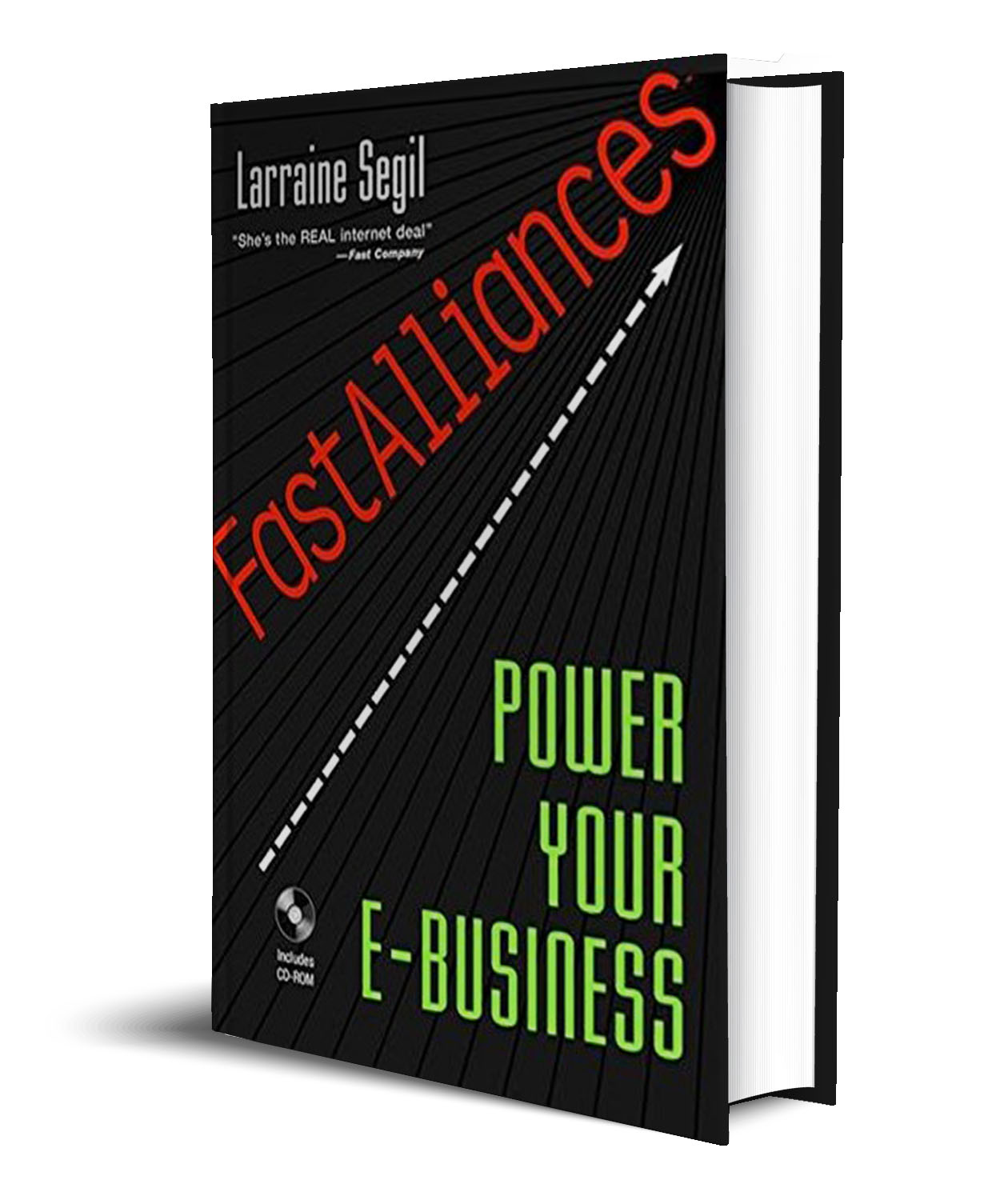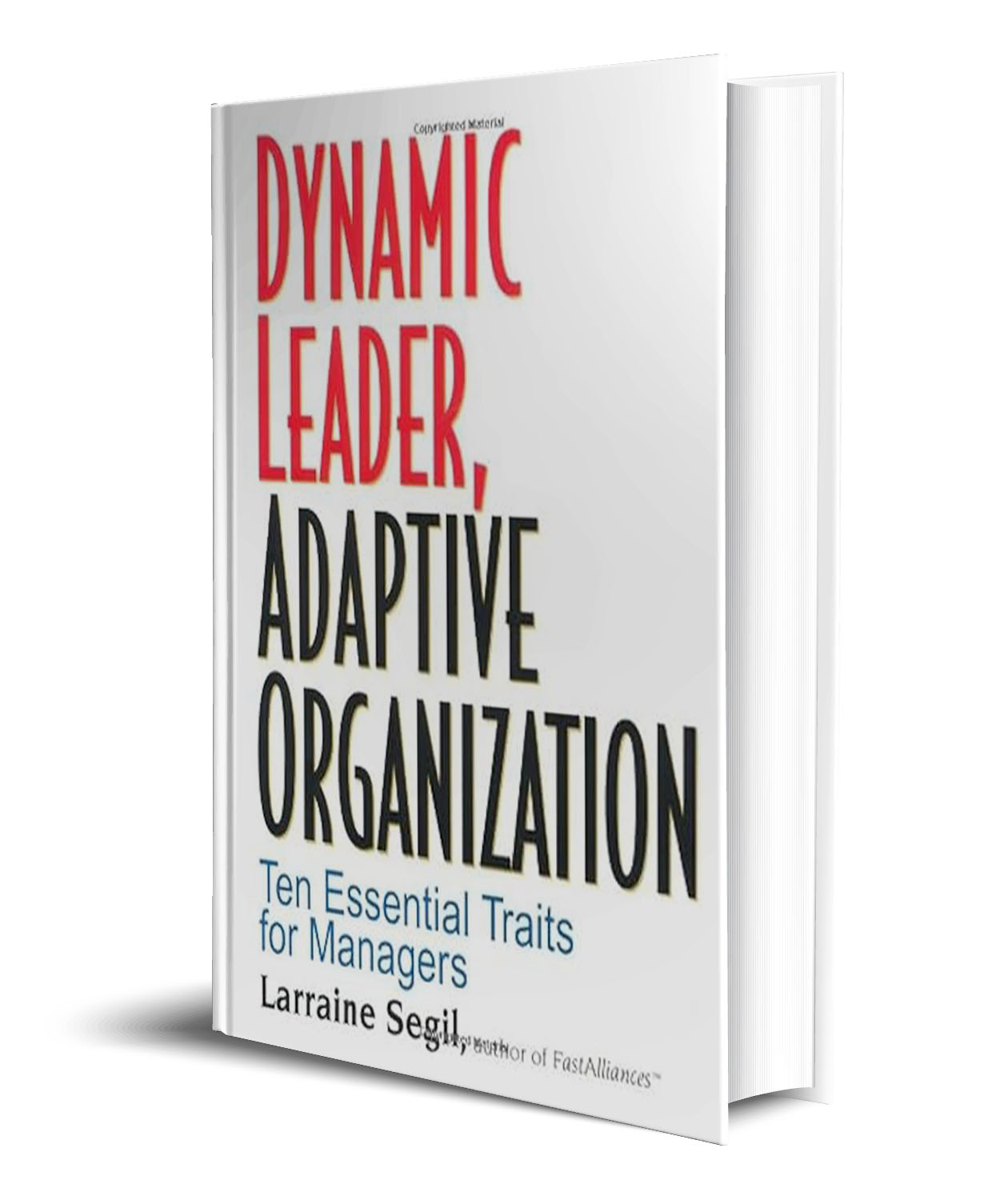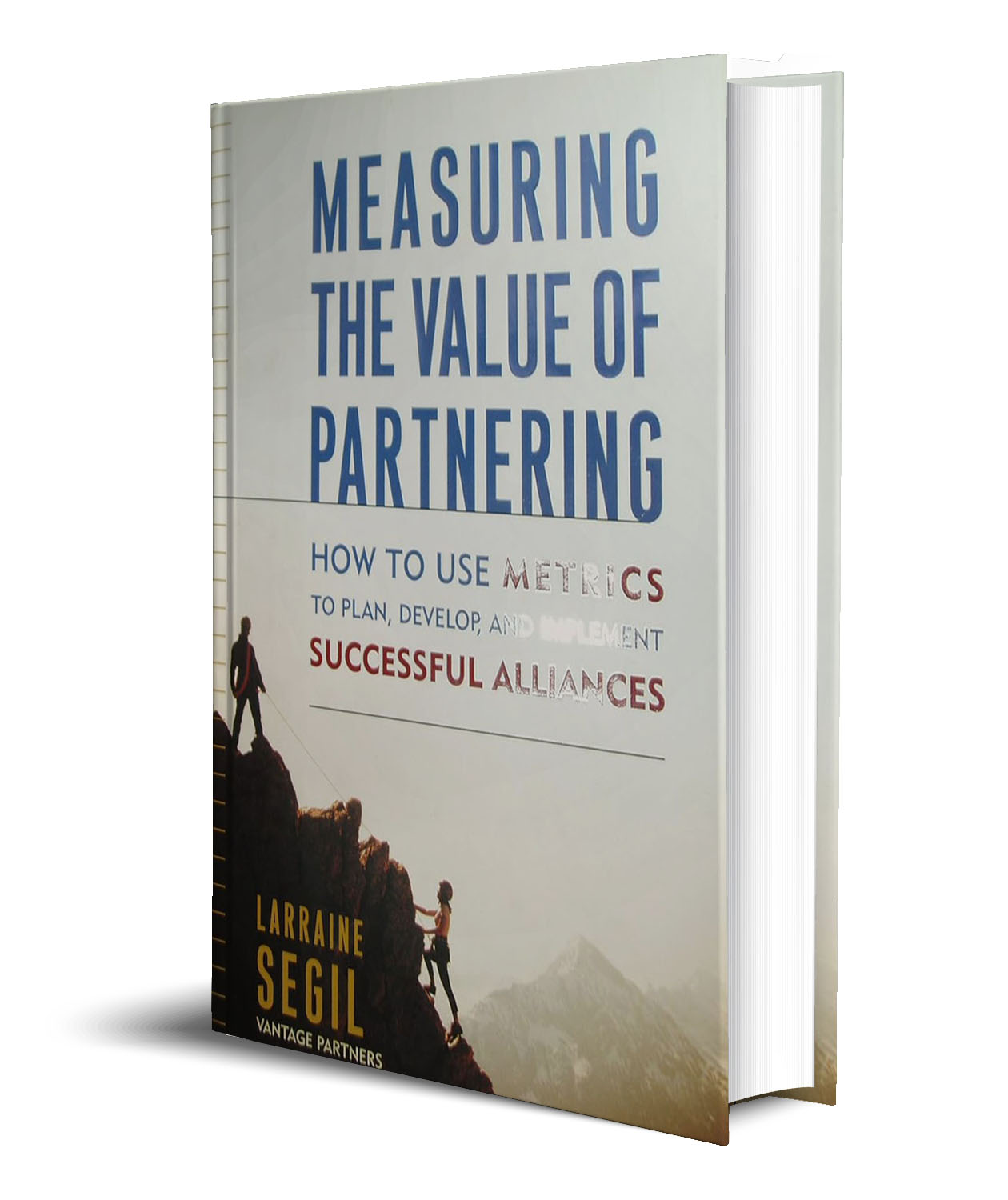She’s the REAL internet Deal
When it comes to evaluating Internet deals, Larraine Segil knows what’s real. She’s advised some of the biggest companies on how to partner with startups, and she’s literally written the book on what she calls “Fast Alliances.”
SO, DO WE HAVE A DEAL?
By: Cheryl Dahle | Photographs By: Larry Hirshowitz
Fast Company November 2000
Would there be an Internet economy without dotcom deals? Business has always had its share of technology alliances, marketing partnerships, and R&D consortia, of course. But there’s something about the Web — the speed with which products get launched, the size of the opportunities facing so many small firms, the risks of coming in second in a fast-growing market — that provokes deals to get made in, well, Internet time. But is there a point to these deals? Does it matter that whatzit.com and whozit.net have announced a “strategic e-commerce alliance”? How can you tell when an Internet partnership is a lot of hot air — and when it’s the real deal?
One way is to ask Larraine Segil. In her 30-year career as an entrepreneur, attorney, and adviser to such companies as Compaq, Sun Microsystems, and Synopsys Inc., the flamboyant native South African has seen (and brokered) more than a few high-tech deals. Indeed, Segil, 52, is something of a one-woman industry on the topic. She is cofounder of the Lared Group, a Los Angeles- based consulting firm with offices from Chile to China that develops strategic alliances. She lectures on the topic to thousands of executives around the world each year, and she teaches a course on the subject at the California Institute of Technology. Her forthcoming book, Fastalliances™ – ”Power Your E-Business (Wiley Publishers), will be out in January.
So what’s the deal with Internet deals? The Web has changed the way that business alliances are made, and the changes apply just as much to brick-and-mortar companies as they do to small dotcoms, Segil argues. The reasons for partnering and the capabilities needed to execute those deals are very different from the motivations and skills behind traditional alliances. “E-customers want information and access,” says Segil.
 |
“They want to understand their problem better and find a solution. Traditional companies tend to provide information only as it relates to what they are selling. So the need for alliances is greater than ever before. Your company alone cannot fulfill the needs of a customer in the e-business environment.” In an interview, Larraine Segil explained the art of the dotcom deal.
How are Internet alliances different from traditional alliances?
Internet alliances are any partnerships formed around e-business strategy. They can be between dotcoms and brick-and-mortar companies, between pure dotcoms, or even between two traditional companies. They are much faster and more flexible than traditional alliances, and the depth of the relationships varies greatly, ranging from what I call a “press-release relationship” to an all-out merger.
| COULD THERE BE AN ECONOMY WITHOUT DOTCOM DEALS? |
They tend not to last as long as traditional alliances; they’re often as brief as three to six months. The life span of the agreement is not the central criterion anymore, whereas in traditional alliances, that’s always a big negotiating point. The rules truly have changed. Nobody in their right mind would look at a 10- or 15-year relationship anymore. Your current e-business partner could be exactly the wrong partner for you 2 years from now because of changes in the competitive landscape.
But how does a press release constitute an alliance? Isn’t that just a bid for attention?
It’s what you’re doing with it that counts. Call it an alliance, call it a press release. Semantics don’t matter. But a press release causes a reaction. And the reaction may not just be that the stock goes up. It may be that people begin to link companies that have issued press releases. So if you happen to follow the press release with some cobannering activity on your Web site, you’re now in the pyramid of relationships. And you’re beginning to migrate upwards toward a deal with more skin in the game for both players.
All you’re saying with that press release is that you have an alliance that hasn’t been properly implemented yet. But there is some aligning going on. And press releases can actually create preemptive alliances, because your competitor sees a press release and says, “Oh my God, we’ve got to find someone to acquire.” And before you know it, the whole dynamic of the industry players has changed. So it’s not an insignificant thing.
 |
How can a company get the most out of its Internet alliances?
The most successful companies look at their partnerships as a cluster, or what I call a “spider network.” The network includes direct partnerships with suppliers, corporate partners, and portals, as well as indirect partner-ships such as those with your suppliers’ suppliers, your partners’ partners, and the other companies that your venture capitalists have invested in. The idea is to look beyond the most obvious alliances to see where value lies. Once you’ve identified all of the alliances that you have, you should rate them for added value and added risk, and allocate resources accordingly. Too many companies pour vast amounts of resources into projects that won’t make a big difference in the success of their e-strategy, or they underfund projects that are absolutely critical.
Softbank Inc. is a great example of a spider network. It started out as a Japanese software company, and now it’s essentially a holding corporation for 300 companies. It has positioned itself as the central intelligence of the spider network. It leverages every style of relationship that it has among the companies that it invests in. Softbank brings together all of its companies to share information and best practices. It is always looking for new ways for its network players to benefit.
Are there times when an Internet deal can hurt a company, instead of helping it?
Definitely. The capabilities of the spider network are limited by the portability of its least portable member, the flexibility of its least flexible member, and the speed of its slowest member. In other words, when you partner with a company, you get the burden of all of its weaknesses, as well as the benefit of its strengths.
Some of that may not matter to you. But portability and mobility, for example, are very important to Ericsson, which has a set of systems in place that allows its employees to work from anywhere in the world and to network with virtually anyone. If Ericsson partners with a company that doesn’t know how to support telecommuting or videoconferencing, that’s a liability. It slows the company down. One classic deal is a big company partnering with lots of dotcoms. Is there one right way to structure such an alliance? How a big company’s e-business activity is structured is a very telling decision. It tells you how to go about setting up and managing Internet alliances. Sun Microsystems says, “We’re the dot in dot.com,” and its e-business initiatives permeate the entire company. Sun says that Internet strategy is everyone’s job. That means that the style of faster Internet deals affects the whole com-~ pany. But at General Motors, the e-GM project is a separate unit, in part because the company recognizes that this particular group is charged not only with devising an e-business strategy but also with changing the culture of the company. With e-GM, most of the deals being retooled and renegotiated are “fast alliances.”
What kinds of mistakes do companies tend to make when forming Internet alliances?
 |
Deal making is relatively easy, but deal execution is not. Let me draw an analogy. In China, the signing of the contract is the be – ginning of the negotiation. In the United States, the signing of the contract is the beginning of the implementation. Many Internet alliances tend to fall into the China model. The deal is made; the deal is cut. And then it sort of backs up and starts all over again, because nobody really knows what to do next in terms of implementation. You actually have to start putting something into play, with metrics – and you’ve got to do it beforehand or on the run. A lot of companies also lack “adult supervision.” The person who provides adult supervision doesn’t have to be a senior executive who is older in terms of years. It just has to be somebody who has had corporate or managerial experience, because those are the people who know how to put together an organization and then run it effectively.
How do you measure the success of an Internet alliance?
With every alliance, the first question to ask is, What are you trying to achieve? Ask yourself what would make you consider this deal a success. This is a very important point, because the definition of success changes as the market changes. It changes as the partners change. But it also changes as the people change. A new team that comes in usually feels the need to redefine what the
alliance is all about. So keeping your eye on the definition of success is really fundamental. Once you have that in mind, there are many different kinds of success. There’s revenue growth. There’s brand, value, and exposure. You might measure page views, click throughs, or transactions.
Another critical question to ask is, Are you in the same mind-set as your partner? Let’s say that your goal is revenue growth, and your partner is a brand-oriented company. Your partner’s goal may be technology transfer. That means that it will approach things differently from you. Your partner is going to have its R&D people in there. It’s going to be examining every piece of software with a fine-tooth comb. Your partner is going to have people trying to find ways to integrate. Meanwhile, you’re thinking, “The hell with that. We’ve got to make some sales here.” You can get into trouble if your goals and your partner’s goals are not complementary.
IN THE INTERNET ENVIRONMENT, SPEED is key to survival. To move fast, you have to strike alliances and make decisions on the fly. In Fastalliances™ – Power Your E-Business, Larraine Segil refers to those attributes as “skinny process.” A classic example, she writes, is Flextronics International, a contract-electronics manufacturer with more than $8.5 billion in annual revenues and a growth rate of more than 60%. With customers including Cisco, Ericsson, and Lucent, the firm’s business is built on partnerships.
How does Flextronics manage to stay skinny? In Fastalliances™, CEO Michael Marks explains.
Match your customers’ pace. ‘Our company is very responsive- We are a traditional brick and mortar company but we do operate with many of the principles of the click companies—– If it wasn’t for us, many of them could not fulfill what they promise.”
Delegate spending authority. “There is over $100 million of capital spending per quarter at Flextronics – and none of it gets to me. A plant manager can make a decision to spend $2 million—–My philosophy is that once you have more than one signature for signoff, there is no value added…So if I am not here, nothing changes, people still keep on making their own decisions.”
Meet less, do more. “We don’t believe in a lot of meetings either. People move fast and are not bogged down. My experience with meetings is that for the first 15 minutes everyone is talking about the project and the next 45 minutes are spent talking about how to get sign off to do it.”






Leave a Reply
You must be logged in to post a comment.